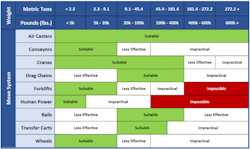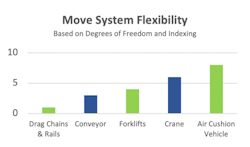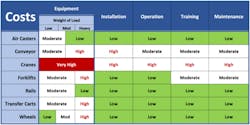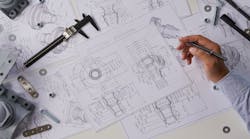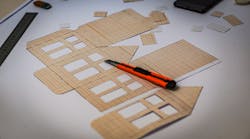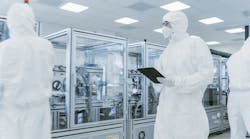7 material handling challenges for pharma facilities
A pharmaceutical company faced a major material handling issue: It had to regularly move a set of 31,000 lb. chromatography columns through its facility, but how? What material handling system could accommodate significant weight, frequent moves, cleanroom environments with delicate floors, a densely packed facility and fitting under low-profile doors?
Identifying the perfect option necessitated a painstaking process of elimination that addressed resolution of seven major load handling challenges. Some were straightforward, such as ensuring the solution could work with the weight class of their equipment, while others were more subtle but no less consequential.
Exploring these issues can serve as a guideline for pharma facilities facing similar situations.
1. Take into consideration the necessary weight classes.
The first challenge, and perhaps the most obvious, is system capacity for moving the intended object. Almost any system can move relatively small loads; for example, in a test lab or cleanroom, people can easily carry samples, supplies and product. However, as weight scales and the operation must move heavier machinery and equipment, fewer material handling systems will suffice. At the same time, new risks are likely to be encountered: e.g., ergonomic strain and injury from systems that require workers to push or pull with substantial force. The following chart weighs (no pun intended) the pros and cons of each load moving system:
2. Protect delicate floors.
Pharma facilities face special considerations with their floor surfaces. Cleanrooms and test labs in particular, often feature raised floors that support only limited floor loading. Even a simple wheeled cart could potentially damage the floor due to a probable weight of thousands of psi at each point of contact.
If flooring is a major consideration, material handling systems that do not contact the floor surface may offer a better option. Any system such as cranes or air casters that raise the load off the floor can protect flooring from damage. Air casters are similar to hovercraft in that they float the load on a nearly frictionless film of pressurized air. That film is no thicker than a business card, but it spreads the load across its entire footprint, potentially reducing floor loading to as little as 25 psi.
3. Evaluate density and space restrictions.
Another potential challenge in choosing a material handling system is the condition of the facility, which can impose significant logistical and operational constraints. Consider wheeled vehicles, most of which require ample space to operate, especially when changing direction. Otherwise, they risk collisions with walls, nearby equipment or even people.
Another option is the use of tuggers, one of the most common solutions in pharma facilities. These wheeled vehicles attach to the load and pull it. That’s probably not a problem with moving forward, but it can be prohibitively difficult to back up or to turn around tight corners, because the load mover contains two segments that pivot at the center. As shown in the following chart, overhead load movers such as cranes or underneath — carts, pallets or air caster systems that fit within the footprint of the column — will easily and deftly navigate the constraints of a tight space.
4. Prevent contamination and cross-contamination.
Most pharmacological operations require stringently and expensively maintained cleanroom environments. That places a priority on selecting a solution that doesn’t introduce particulates, volatile organic compounds or other contaminants into the environment. Systems that produce exhaust emissions, require oils or grease to operate, and/or contain components that could potentially cause off-gassing will have to be eliminated. Cross-contamination between environments can also be an issue if the facility has to transport equipment, machinery or product between environments. That scenario may rule out the use of certain material handling systems such as cranes, which might not be capable of navigating between separate environments without increasing the risk of contamination.
5: Protect equipment against vibration and shock loads.
Chromatography columns are unusually delicate, particularly after they’ve been freshly packed. Here, the key is to isolate the load from vibration and shock. That poses a problem for the use of wheeled vehicles that can potentially transmit any imperfections in the floor (bumps, grooves, gaps) to the equipment due to vibration. Air casters appear to be the better choice because the inflated bag that powers the casters effectively acts as a suspension system absorbing potential vibration and shock loads before they can affect the media within the column.
6. Maintain and improve productive capacity.
Another challenge, all too often overlooked, is assuring the material handling system facilitates or even improves the facility’s productive capacity. Some systems may take at least a half hour or more for a single move when the set up (system preparation and placing the load onto the system), operation (system maneuvering), and wind down (removing the load and storing or moving the system to its next location) are complex or time-consuming. That can affect dwell, takt and process cycle times, which all potentially affect productive capacity.
7. Control costs.
It should surprise no one that the last challenge is cost and budgetary requirements. This can be the most perplexing in choosing the right material handling system. One reason: costs cannot necessarily be compared one-for-one. Each system will incur an upfront capital expense to purchase and implement, but those expenses represent just a fraction of the total cost of ownership. The cost of ongoing operation can vary significantly, particularly if the system requires trained and certified operators (e.g., cranes and forklifts). Maintenance costs are major variables. Every mechanical system will require ongoing repairs and upkeep as will any system with tires.
This is where the evaluation of opportunity costs comes into play. The wrong material handling system will limit productive capacity and possibly the ability of an operation to flexibly accommodate future change, such as updating the facility layout. Ultimately, the cost challenge requires facilities to balance upfront cost against long-term costs that should not be overlooked as the following chart explains:
The deciding factor
By systematically evaluating and working through each of the seven challenges, operations are in the best position to choose the most effective load movement system for their facility and environment. Ultimately, there is always a key factor that narrows down available options. In the case of the chromatography column-moving pharmaceutical company mentioned previously, the balance of features — cost-effective movement of heavy loads without damaging floors or contaminating cleanrooms — was the deciding factor. Other facilities might arrive at a different answer depending on the most important factors in need of mitigation.

